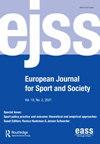HEART RATE INDICATORS WITHIN TRAINING EXERCISES OF UKRAINIAN AND CHINESE BADMINTON PLAYERS AGED 10-12 YEARS
IF 1
Q2 HOSPITALITY, LEISURE, SPORT & TOURISM
引用次数: 0
Abstract
We have found the contradiction between the current requirements of competitive activities and insufficient justification of the methodological provisions of various aspects of the training of qualified badminton players, which led to the urgent scientific and practical task. An important aspect of this is the comparison of exercise load data (in terms of heart rate) between Ukrainian and Chinese badminton players in the same age group. Aim: to compare the heart rate of Ukrainian and Chinese badminton players aged 10-12 years within the training exercises. Material & Methods. We have used theoretical analysis and generalisation of scientific and methodological data, pedagogical observations of heart rate during training exercises of badminton players aged 10-12 years (the first zone provided for indicators within 124 bpm, the 2 – 125-145 bpm, the 3 – 146-166 bpm, the 4 – 167-187 bpm, and the 5 – more than 188 bpm), methods of mathematical statistics. During 2019, training exercises with the participation of 102 Ukrainian and 112 Chinese badminton players aged 10-12 were analysed. Results. Chinese athletes perform more intense loads, which are characterised by increased heart rate indicators and reflected in the share of those being in the fifth heart rate zone. At the same time, Ukrainian badminton players achieve a significantly higher (p≤0.01) average heart rate level by compensating for the use of marginal and near-marginal intensity in exercises, by increasing the amount of exercise performed in the third and partially second heart rate zones. Significant predominance (p≤0.01) of Chinese badminton players was found in the total duration of training sessions (20.03%), absolute and relative values of being in the first (59.04−87.12%) and the fifth (230−297%) heart rate zones, the number of moving to the fifth heart rate zone (173.02%). Ukrainian badminton players significantly (p≤0.05) outperform their Chinese peers in the average heart rate indicator of the athlete in training (2.72%), the absolute values of being in the second heart rate zone (16.91%), absolute and relative values of being in the third heart rate zone (16.95-31.11%). Conclusions. During the preparation of Chinese athletes, more attention is paid to the systematic and gradual increase in physical load (in terms of volume and intensity) compared to the Ukrainian peers. Based on the identified structure, we assume that moving from one level of physical load to another one takes place according to the alternation of loads of different intensity and volume.乌克兰和中国10-12岁羽毛球运动员训练中的心率指标
我们发现了当前竞技活动的要求与羽毛球运动员培养各方面的方法论规定不充分之间的矛盾,导致了迫切的科学和实践任务。其中一个重要的方面是乌克兰和中国羽毛球运动员在同一年龄组的运动负荷数据(以心率计算)的比较。目的:比较乌克兰和中国10-12岁羽毛球运动员在训练过程中的心率。材料与方法。我们对10-12岁羽毛球运动员在训练过程中的心率进行了理论分析和归纳,并对其进行了教学观察(第一个区域提供了124 bpm以内的指标,2 - 125-145 bpm, 3 - 146-166 bpm, 4 - 167-187 bpm和5-超过188 bpm),以及数学统计方法。2019年,对102名10-12岁乌克兰和112名中国羽毛球运动员参加的训练进行了分析。结果。中国运动员表现出更强的负荷,其特点是心率指标增加,并反映在处于第五心率区的运动员所占比例上。同时,乌克兰羽毛球运动员通过增加第三心率区和部分第二心率区的运动量来补偿运动中边际和近边际强度的使用,获得了显著更高的平均心率水平(p≤0.01)。中国羽毛球运动员在总训练时间(20.03%)、处于第一心率区(59.04 ~ 87.12%)和第五心率区(230 ~ 297%)的绝对值和相对值、进入第五心率区的次数(173.02%)均显著优势(p≤0.01)。乌克兰羽毛球运动员在训练中平均心率指标(2.72%)、第二心率区绝对值(16.91%)、第三心率区绝对值和相对值(16.95 ~ 31.11%)均显著优于中国运动员(p≤0.05)。结论。与乌克兰运动员相比,中国运动员在备战过程中更注重身体负荷(在体积和强度方面)的系统和逐步增加。根据已确定的结构,我们假设根据不同强度和体积的荷载的交替,从一个物理荷载水平移动到另一个物理荷载水平。
本文章由计算机程序翻译,如有差异,请以英文原文为准。
求助全文
约1分钟内获得全文
求助全文
来源期刊

European Journal for Sport and Society
HOSPITALITY, LEISURE, SPORT & TOURISM-
CiteScore
3.30
自引率
4.20%
发文量
17
 求助内容:
求助内容: 应助结果提醒方式:
应助结果提醒方式:


